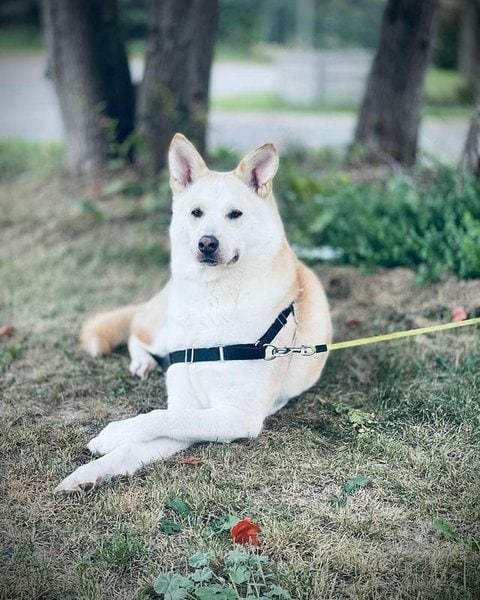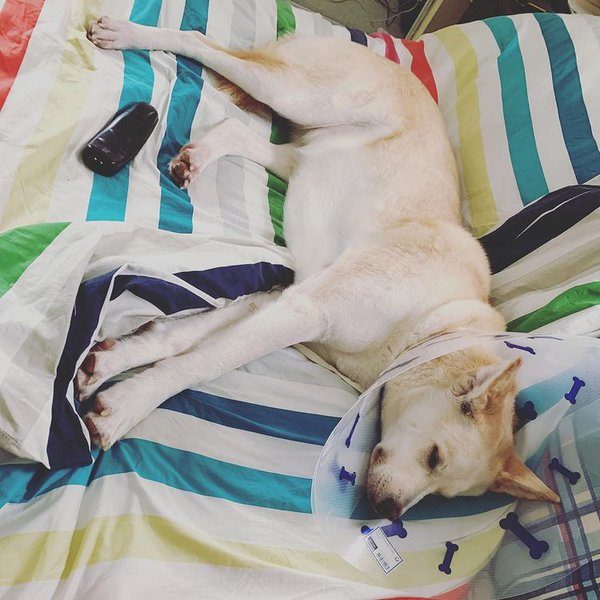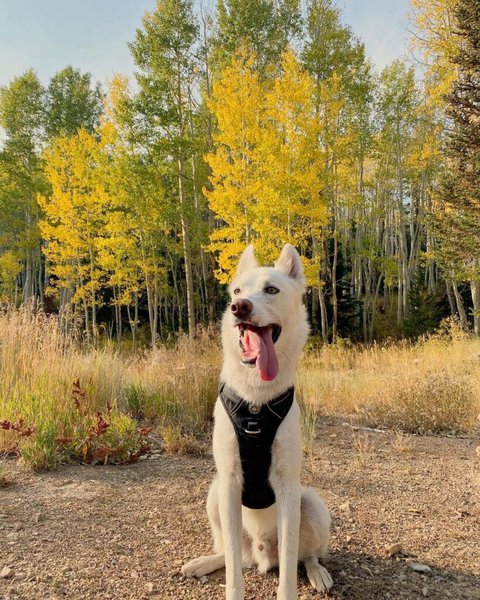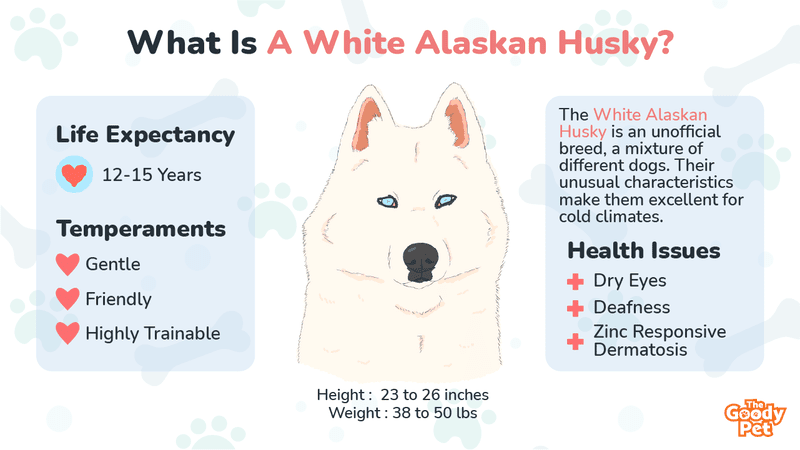With a graceful body, pointed ears, soft dense fur, a wolf-like appearance, and brown eyes, the White Alaskan Husky is one of its kind. You won’t be able to keep your eyes off this dog.
The White Alaskan Husky is an unofficial breed, a mixture of different dogs. Their unusual characteristics make them excellent for cold climates. Their sparkling eyes and wolf-like appearance make them resemble Siberian Huskies and Alaskan Malamutes, but Alaskan Huskies are a bit taller than their Siberian counterparts.
White Alaskan Huskies are sled dogs typically found in cold regions. They have amazing endurance and speed. They are generally bred because of their endurance and ability to work, not their looks.
So, White Alaskan Huskies make splendid companions for backpackers and hikers because of their energetic and competitive nature. Let’s have a more detailed look at the characteristics of this majestic dog, including their physical characteristics, common health concerns, temperament, and care tips. Let’s start with their size.
How Big Do White Alaskan Huskies Get?

White Alaskan Huskies are medium-to-large size dogs with plenty of energy. While they resemble Alaskan Malamutes and Siberian Huskies, they have some major physical differences.
Since White Alaskan Huskies are a mix of different breeds, they come in a large variety of sizes. They typically stand between 23 and 26 inches and weigh around 38 to 50 lbs. White Alaskan Huskies were bred as sled dogs but also proved to be good companion pets.
The Finer Aspects
The White Alaskan Husky is an unofficial breed, a mixture of different dogs, making them stand out because of their unique features. Usually, they are medium-to-large size dogs, but their characteristics sometimes differ because of varying parent genes.
Their triangular erected ears often look like a cross between a Siberian Husky and an Alaskan Malamute. They have extended legs, a lean body, a deep chest, and various fur colors.
After more than a century of crossbreeding primarily with English Pointers, German Shepherds, and Salukis, the modern Alaskan Husky breed has several performant traits, such as agility, pulling strength, and top speed. You can be absolutely certain to see these traits in your White Alaskan Husky.
Coat Color And Pattern
White Alaskan Huskies are considered to be rare dog breeds. White is not the Husky’s original coat color, and this gene-controlled characteristic was only later expressed in the offspring of two white-colored parents.
White Alaskan Huskies are easy to groom. They shed their thick coats only twice a year before the season changes. They are covered with dense white fur of short-to-medium length, with a curved bushy tail that keeps them warm in cold regions. This is one reason you shouldn’t keep them in apartments or other hot areas.
Sparkling Eyes
White Alaskan Huskies’ eye color may be confused with Siberian Huskies. While Alaskan Huskies tend to have shiny brown eyes, Siberian Huskies have either blue eyes or a mix of blue and brown. White Alaskan Huskies’ irresistible brown eyes beautify their matching white coat.
How Long Do White Alaskan Huskies Live?

White Alaskan Huskies typically live 12 to 15 years because they are considered a healthy breed with a high-energy level.
However, your doggie can succumb to genetic diseases found in pure breeds. We will discuss some common ailments below, but if your canine shows symptoms of any of these, consult your vet.
Progressive Retinal Atrophy
PRA can gradually worsen vision until your canine becomes completely blind. PRA is not painful, but if your doggie avoids going into the dark or bumps into things in dim lighting, visit the vet for early treatment.
Alaskan Husky Encephalopathy
AHE is a fatal brain disease. Signs to watch for include seizures, trouble walking, trouble eating, and vision problems.
AHE is caused by a lack of protein, and it affects juvenile and young, adult female and male White Alaskan Huskies. This disease is genetic, occurring in offspring only if one or both parents had AHE.
Zinc Responsive Dermatosis
If your pooch has red, crusty spots on their skin, this may be a sign of zinc-responsive dermatosis. In this condition, your pooch will display a lackluster coat, brittle nails, and may look extremely thin no matter how much they eat.
Dry Eyes
Having dry eyes is a painful condition that can occur because of a faulty immune system that may cause other hormonal problems. If you notice a dried discharge around the eyes, cloudy or red eyes, your doggies closing their eyes or blinking more than usual, consult your vet.
Deafness
White Alaskan Huskies are often affected by deafness because of their piebald gene (absence of cells, which create pigment) which causes their predominantly white coat.
Although this disease is not a threat to life, it causes inconvenience for your canine and sometimes for you as an owner. Therefore, it is best to work to prevent it or train your pooch to work around it.
How To Take Care Of Your White Alaskan Husky?
There are several factors to consider when taking care of your White Alaskan Husky. Providing a safe and dog-friendly environment helps maintain a balanced temperament. You can give them toys when they feel playful and take them for long walks when they need exercise.
The healthy growth of your pooch highly depends on attending to their hygiene, including brushing and cutting their nails, cleaning their ears and teeth, and keeping their feeding bowl clean.
The Right Amount Of Nutrition
A balanced diet will help build the proper immune system for your canine. Since White Alaskan Huskies are known to have an unexceptional appetite, you need to keep a balanced diet of protein, fats, carbohydrates, vitamins, and minerals to make sure your doggie’s weight doesn’t fall or rise too far beyond its average.
The Association of American Feed Control Officials (AAFCO) has stated the key nutrients for dogs. A minimum of 22% protein and 8% fat for growth and 18% protein and 5% fat for adult dogs. Too much protein will often cause urine excretion, so your White Alaskan Husky will leave yellow spots behind.
What Amount To Feed
The general question that arises in every dog owner’s mind is the number of cups of food White Alaskan Husky will need.
The size of your pooch’s meal increases with their age. For an 8 week-old puppy, feed 3 to 4 meals a day. By 12 to 16 weeks, feed two to three times a day. By 6 months, feed one meal a day.
White Alaskan Huskies do not eat frequently. So as they age, their amount of food decreases to one meal per day. Even if you give your furry friend full access to food, it doesn’t affect them as they eat limited food, unlike other dogs, and still live a healthy and active life.
Recommended Foods:
- Peas, corn, carrots, beans, rice, pasta, and grains (For carbohydrates)
- Foods in fish oil, vegetable oil, poultry fat, and tallow (For fats)
- Cooked meat and poultry (For protein)
- Natural foods like whole grains, fruits, vegetables, and more valuable sources other than synthetic supplements (For vitamins and minerals)
Not recommended foods:
- Alcohol
- Sweets and sugar
- Onion and garlic
- Milk
- Raw meat
- Yeast dough
- Fat trimmings and bones
- Raw eggs
- Salty foods
Pet Plate is the ideal solution for incorporating recommended foods and avoiding bad foods for your dog.
Bad Diet Effects
If your canine is on a bad diet, you’ll often see the signs: loose stools, dandruff problems, excessive shedding, dull coat, obesity, skin disorders, and more. You should consult your vet if you like to overcome these issues in your White Alaskan Husky.
Provide Lots Of Exercises
An exercised White Alaskan Husky is a healthy and happy Husky. To avoid health risks, make your canine exercise but do not overwork your canine friend.
For a one-month-old puppy, 5 minutes of exercise per day is enough. Extend the session with additional 5-minute increments for each passing month. For example, a two-month-old pup needs 10 minutes of exercise per day, whereas a three-month-old pup needs at least 15 minutes.
Adults need at least 20 minutes of exercise per day. White Alaskan Huskies find many ways to make their exercise exciting by playing tug-of-war or hide-and-seek, learning new tricks, or joining you on a hike.
If they don’t exercise, they can easily get bored. Then they’re more likely to dig, howl, or chew anything they find. Make sure to keep your doggie hydrated and let them rest up for 5 to 10 minutes if you take a long walk.
The White Alaskan Husky is athletic and so requires the athletes’ exercise. They are faster than other Husky breeds and suitable for sports. Furthermore, this breed has a winning speed touting to be the 7th fastest dog in the world and can run for long distances up to 1,000 miles.
Dental Water Additives
Proper dental care is another vital component of your canine’s health. To avoid periodontal diseases, use dental water additives to prevent the buildup of plaque and tartar, which also result in bad breath.
Good dental hygiene, such as regular brushing of teeth, also reduces the risk of gum-related diseases in your White Alaskan Husky.
Are White Alaskan Huskies Aggressive? Temperaments Of White Alaskan Huskies
White Alaskan Huskies are not aggressive or dangerous. In fact, they are very friendly, gentle, and admirable companions.
They are well-known as jumpers, as this is their way to show affection. They’re also avid cuddlers. If your canine loves you wholeheartedly, then they’ll expect the same in return.
White Alaskan Huskies are not overly suspicious, so they’re terrible guard dogs. Because they’re less aggressive, they are very sociable. The White Alaskan Husky befriends strangers because they constantly crave company.
Highly Trainable
White Alaskan Huskies are easily trainable even as they age, but they become dominant and stubborn at times, so you must have strong leadership skills to train them well. They are great for outdoor activities like sports, picnics, and hiking. Your canine will love you a lot if you are adventurous.

Protective And Devoted
White Alaskan Huskies are affectionate and protective of their owners. The American Society for the Prevention of Cruelty to Animals (ASPCA) clarifies that you can trust Huskies with children. They are not good as guard dogs, but because of their protective nature, they can protect children anytime whenever they sense something is wrong.
Do White Alaskan Huskies Shed A Lot? Grooming Tips For White Alaskan Huskies
White Alaskan Huskies don’t shed all year round, unlike other double-coated dogs like the Siberian Husky. They only shed twice a year, thereby requiring less grooming. They mostly self-clean, but require brushing daily to remove dead hair.
Despite not shedding all year round, these white Alaskan Huskies are not considered to be hypoallergenic as they do shed during the shedding seasons.
Benefits Of Regular Grooming
Regularly grooming your canine strengthens your bond and also prevents health issues. Your canine will look and smell better, and you can more easily observe skin disease symptoms with regular grooming. Grooming also reduces the danger of nail and ear infections.
Guide To Groom
It is not an easy task to groom a heavy-coated pooch. Following basic requirements will be enough to properly groom your canine.
- Before giving a bath, brush your canine to untangle its hair and de-shed any loose undercoat. For the de-shedding purpose, we recommend the Furminator Undercoat Tool. It comes with an ergonomic handle that enables smoother brushing motion, thereby shortening each brushing session your pooch has to go through.
- Use a good fragrance shampoo and conditioner. To maintain the white outlook of your White Alaskan Husky, we recommend the Seamus Cherry Blossom Whitening Dog Shampoo. Its formulation comes with a Pharmasome technology to whiten dark spots and maintain the coat’s overall appearance.
- Wash out their anal sacs, if needed.
- Avoid using shampoo near your pooch’s eyes and ears. Always exercise caution while cleaning your pooch’s face.
- Trim their nails.
- Brush their teeth.
- Once again, brush their hair after you dry them with a towel or blow dryer.
Related Questions
How Much Is A White Alaskan Husky? A healthy White Alaskan Husky puppy usually costs from $1,000 to $1,500. Although a White Alaskan Husky is not considered a pure breed, it is still a highly efficient working sled dog, which is why it is worth it. Moreover, White Alaskan Huskies are considerably rare as all-white is not one of the breed’s original color markings.
Can White Alaskan Huskies Swim? No, White Alaskan Huskies can’t swim but like to splash water and play in a shallow paddling pool. White Alaskan Huskies are athletic and strong, but at some level, they fear water. You can teach your canine to swim, but make them wear a life jacket to make your canine comfortable.
Are White Alaskan Huskies Recognized By The American Kennel Club? White Alaskan Huskies are an unofficial breed and not recognized by the American Kennel Club to date. They are only bred as working sled dogs by a mix of different breed dogs, but they also prove to be good companions and affectionate pets.





